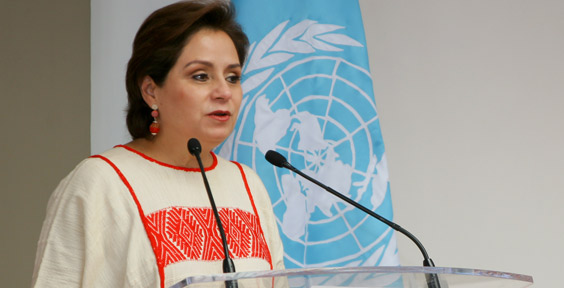Patricia Espinosa, Executive Secretary of the United Nations Framework Convention on Climate Change (UNFCCC), in this treatise published in Gulf News, describes the next two years as key in cementing global response to climate change

In 2015, close to 200 countries – backed by cities, regions, businesses and citizens – agreed to work together towards a low carbon, safer and sustainable future via the Paris Climate Change Agreement.
Less than 12 months later, this remarkable agreement came into force as country after country transformed their pledges into national policies.
But the time has come to step up and accelerate that action even more and there is one profound and fundamental reason why.
The signals from planet Earth are becoming even more worrisome: Greenhouse gas concentrations, which cause global warming, are still rising and in recent months have crossed some key thresholds. The year 2016, for example, has been confirmed as the warmest on record, warmer than 2015 by almost 0.2 degrees Celsius, according to the European Union’s Copernicus Climate Change Service.
The extent of Arctic sea ice – a key barometer of climate change – in December 2016 averaged 12.10 million square kilometres, the second lowest December extent in the satellite record, says the United States National Snow and Ice Data Centre. Seven countries in southern Africa have been experiencing serious drought and in Madagascar, an estimated one million people need food support after several years of failed rainfall. Summer temperatures in 2016 brought record heat to the Middle East. A site in Kuwait hit 54 degrees Celsius in July. The World Meteorological Organisation is investigating if that was the hottest temperature ever recorded in the Eastern Hemisphere.
Just a few reasons why, over the next two years, real action is needed to implement national plans and pledges with a sense of urgency so that every person can be confident that a sustainable future with the minimum damage possible is a real possibility for over seven billion people.
This is no less than a transformational change in the way humans produce and consume power and resources. The costs of failure are unthinkable. The rewards of success – in lives saved, livelihoods secured and scarcity avoided – are universal.
There are three broad and interlinked avenues of effort that will get this unprecedented global job done most efficiently and quickly. This includes national climate action by all countries across public and private sectors, intensive international cooperation and a comprehensive shift in public and private investment towards clean, renewable energy and resilient infrastructures.
At this year’s Abu Dhabi Sustainability Week, I was most encouraged to note that the UAE is among the many nations passionately embracing this positive future. From new standards for air conditioning to cutting-edge technologies demonstrated in Masdar City, the UAE has put efficiency at the heart of its domestic energy strategy and has also provided extensive support and investment for renewable energy in other developing countries.
The UAE is also developing a cross-governmental approach led at a high level and seeking to decouple economic growth from rising emissions and other negative environmental impacts through policies and targets across seven key sectors.
This sends a most important message that only a truly national response to climate change will be effective if mirrored North and South, East and West.
Globally, the news is also encouraging. Almost all countries submitted intended national climate plans in support of the Paris Agreement and almost 120 have now turned those intentions into firm plans under the Agreement. In addition, the first very long-term emissions reduction plans have started to appear, so far from Canada, France, Germany, Mexico and the United States, in response to the Agreement’s recognition that clarity and direction over decades is required.
Global finance flows for climate action continue to rise and should reasonably soon reach one $1 trillion (Dh3.67 trillion) per year. That is still not enough, though.
Approaching the scale required is underlined by the latest news from China alone, which said it will invest the equivalent of about $360 billion into renewable power by 2020, creating more than 13 million jobs.
Last November’s climate change conference in Marrakech, Morocco, also highlighted the growing alignment of government and “non-party stakeholder” action.
For example, a club of subnational governments, the Under2 Coalition, who have committed to reduce their emissions by at least 80 per cent by 2050, announced their membership has grown to 165. It represents a third of the global economy and a population of around one billion people across North America, Europe, Latin America, Africa and Asia.
The Climate Vulnerable Forum of more than 40 nations issued a Marrakech Vision, committing themselves to ambitious aims, including 100 per cent renewable energy between 2030 and 2050.
International climate change negotiations under the United Nations, which this year will be hosted in Bonn, Germany, under the Presidency of Fiji, also need to make significant progress. Governments have indicated a fast-track date of 2018 for completion of the Paris Agreement’s international rule book.
Think of it as the operating manual to deliver a transparent global accounting of emissions reduction, provision for climate finance, technology development and transfer and adaptation needs. The details of the task are complex, but the principle is simple: Transparency builds trust that countries are delivering on their pledges which, in turn, generate the confidence for all countries to increase their own action on climate change to the best of their abilities.
In summary, the necessary pledges, plans and finance are growing across all levels of government, civil society and business.
As we begin 2017, the tipping points into a truly sustainable future look closer than ever so that, by the end of 2018, the foundations for the full transformation will be complete and unbreakable.
